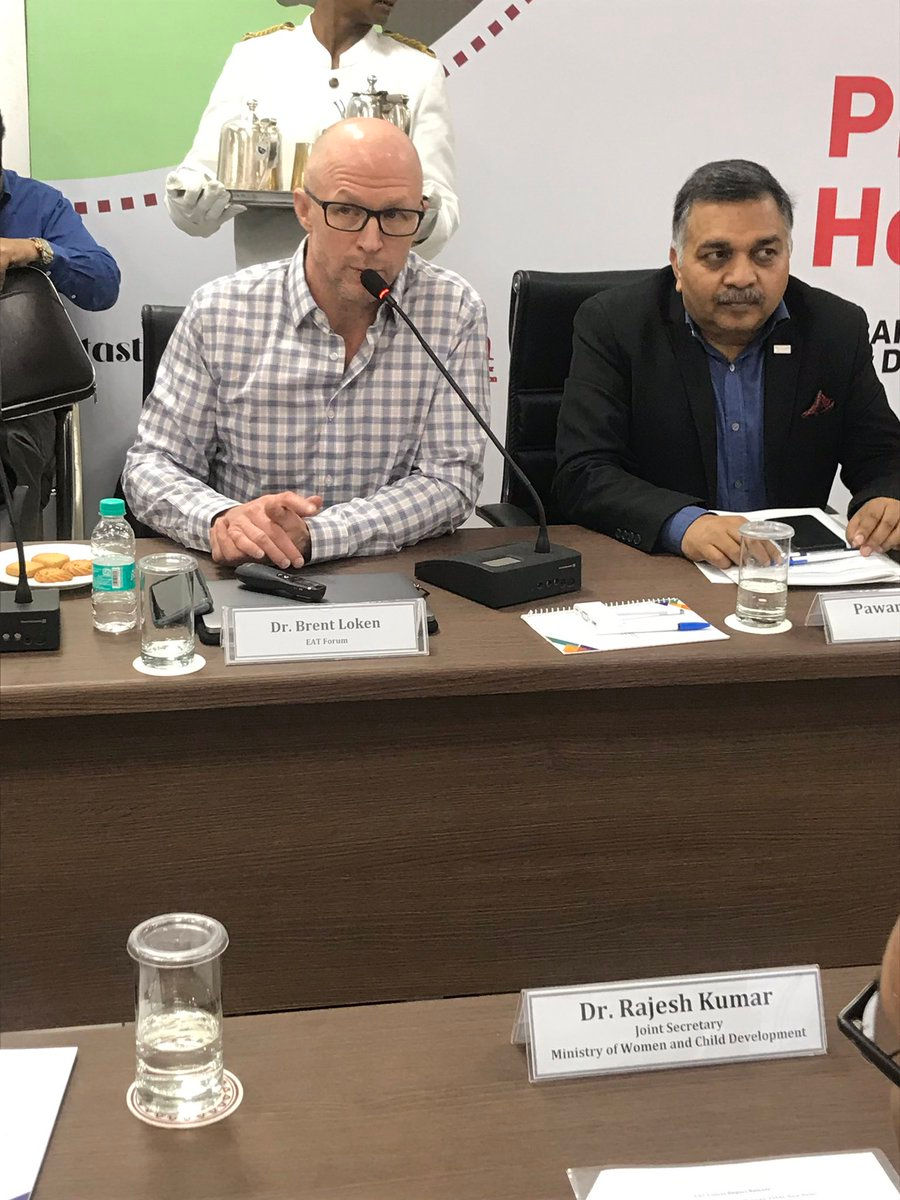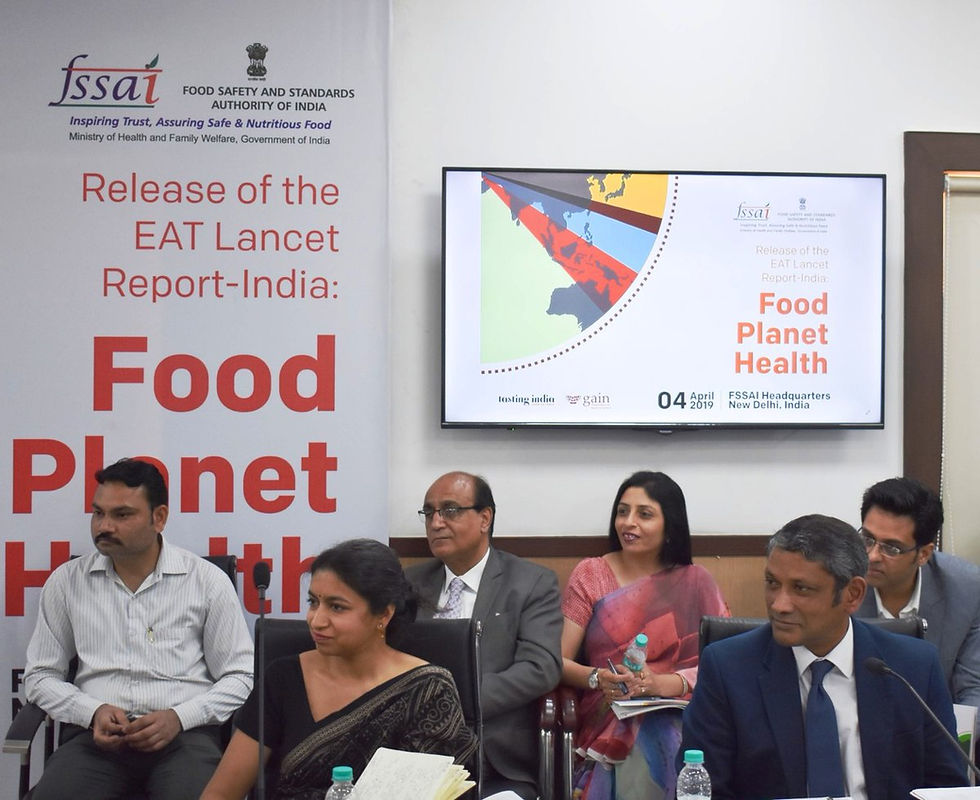EAT-Lancet Commission released report on healthy diet
- Sanjay Trivedi
- Apr 5, 2019
- 4 min read

EAT-Lancet Commission released report on healthy diet in India. The report, authored by 37 international experts, including two from India, has been put together by EAT, the science-based global platform for food system transformation, and the journal The Lancet. The EAT-Lancet Commission’s report, for the first time proposes scientific targets for what constitutes a healthy diet derived from a sustainable food system.
"Feeding India a healthy diet in a sustainable manner without compromising our environment is going to be a quintessential challenge for us in the future. Hence, the framework provided in this report is very important.”
- Pawan Agarwal
chief executive officer
Food Safety and Standards Authority of India

The food we eat, the ways we produce it, and the amounts wasted or lost have major impacts on human health and environmental sustainability. Getting it right with food will be an important way for countries to achieve the targets of the UN Sustainable Development Goals and the Paris Agreement on climate change.
A diet that includes more plant-based foods and fewer animal source foods is healthy, sustainable, and good for both people and planet. It is not a question of all or nothing, but rather small changes for a large and positive impact.
Today, agriculture occupies nearly 40% of global land, making agroecosystems the largest terrestrial ecosystems on the planet. Food production is responsible for up to 30% of global greenhouse gas emissions and 70% of freshwater use. Land conversion for food production is the single most important driver of biodiversity loss.
Foods sourced from animals, especially red meat, have relatively high environmental footprints per serving compared to other food groups. This has an impact on greenhouse gas emissions, land use and biodiversity loss. This is particularly the case for animal source foods from grain fed livestock.
What is or is not consumed are both major drivers of malnutrition in various forms. Globally, over 820 million people continue to go hungry every day, 150 million children suffer from long-term hunger that impairs their growth and development, and 50 million children are acutely hungry due to insufficient access to food.

In parallel, the world is also experiencing a rise in overweight and obesity. Today, over 2 billion adults are overweight and obese, and diet-related noncommunicable diseases including diabetes, cancer and heart diseases are among the leading causes of global deaths.
Good food can be a powerful driver of change: The EAT-Lancet Commission outlines a planetary health diet, which is flexible and recommends intake levels of various food groups that we can adapt to our local geography, culinary traditions and personal preferences. By choosing this diet, we can drive demand for the right foods and send clear market signals all the way through the food value chain back to the farmers.
Globally, the planetary health diet favors increasing the consumption of a variety of fruits, vegetables, nuts and legumes alongside small portions of meat and dairy. In parts of the world, this diet involves increasing the access to certain food groups while in other areas, the diet requires a significant reduction in the overconsumption of unhealthier foods.
Shifting from unhealthy diets to the planetary health diet can prevent 11 million premature adult deaths per year and drive the transition toward a sustainable global food system by 2050 that ensures healthy food for all within planetary boundaries.

What can you do?
Choose health, sustainability and deliciousness. Sourcing, buying, cooking and eating healthier and more sustainably produced food is better for our bodies and for the planet.
Prepare to increase, diversify and reduce.There is no silver bullet but solving the problem starts with changing what we eat and waste. We should eat more fruits, vegetables, nuts, legumes and whole grains, and it is also important to eat a variety to ensure that we get all the nutrients we need while also supporting biodiversity in the food system. Many in wealthier countries should also eat less red meat and dairy.
Dive into the breadth of options. There is something for everyone across price ranges, cultures, age groups and individual preferences. With more than 30,000 known edible plants, we have a lifetime’s worth of interesting options to taste and explore.
Embrace plants as a source of protein. Many plants are both healthy and sustainable sources of dietary protein. Aim to consume at least 125 grams of dry beans, lentils, peas and other nuts or legumes per day.
Go easy on meat consumption. While meat is an important source of key nutrients including protein, iron and vitamin B12, excess meat consumption can harm our health and the planet. Aim to consume no more than 98 grams of red meat (pork, beef or lamb), 203 grams of poultry and 196 grams of fish per week.
Approach food in moderation. Consuming too much food can lead to weight gain and other health problems and it is also a challenge for the environment. Taking the time to share meals with family and friends and choosing single serving portions are two simple ways to avoid eating more than we need.
Support regenerative farming practices. As livestock are central to sustainable farming, sourcing meat from farmers that practice regenerative agriculture can support the fight against climate change. This type of farming contributes to carbon storage in the soil, keeps water away from pollutants, and provides room for local biodiversity to flourish.
Vote with every plate. As markets follow demand, purchase foods that are suitable for our recipes but also good for our health and the planet. Consider making choices that provide additional benefits for human health and the environment, for example by supporting environmentally sustainable and socially responsible farming.
Plan the week ahead. Healthy and sustainable eating can be tasty, flexible and dynamic. Plan menus for the coming week to ensure a diversity of delicious dishes and shop according to plan. This will also save time and money and help reduce waste.
Bring biodiversity to the table. Bold conservation targets require collaboration between farmers and farming communities to maintain habitats on or around farms and to preserve ecosystems. Purchase foods from farmers and retailers who support biodiversity.
Cook more at home. Cooking and preparing food at home provides great opportunities for shared family time. It also allows for recipes to be passed along from generation to generation including their unique stories and tastes.
Waste not, want not. Packing leftovers into lunch boxes, using them in new creative recipes or keeping them for future consumption is good for the planet and for your budget. With less food waste, less food needs to be produced to feed the world and the planet can be spared.







Comments